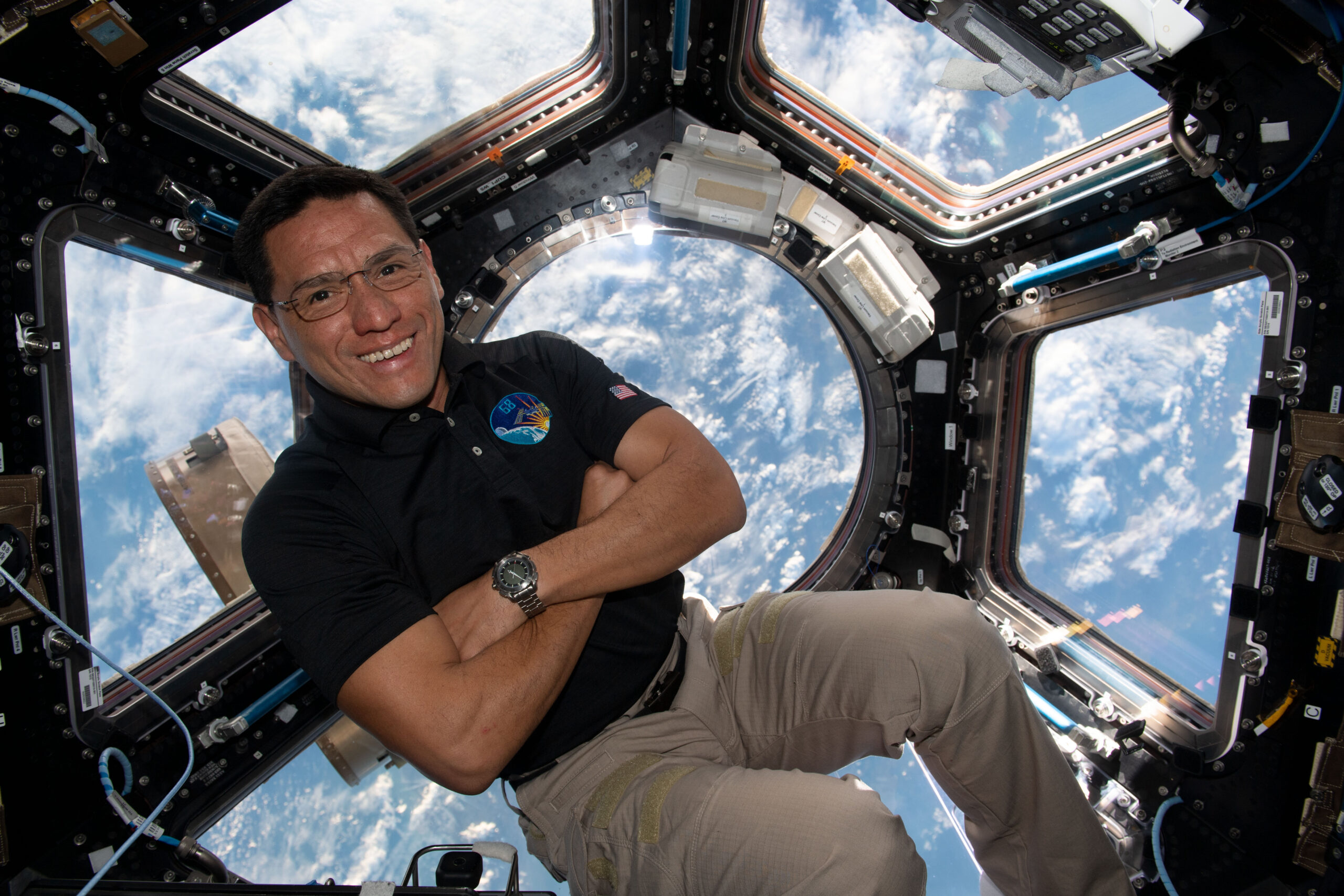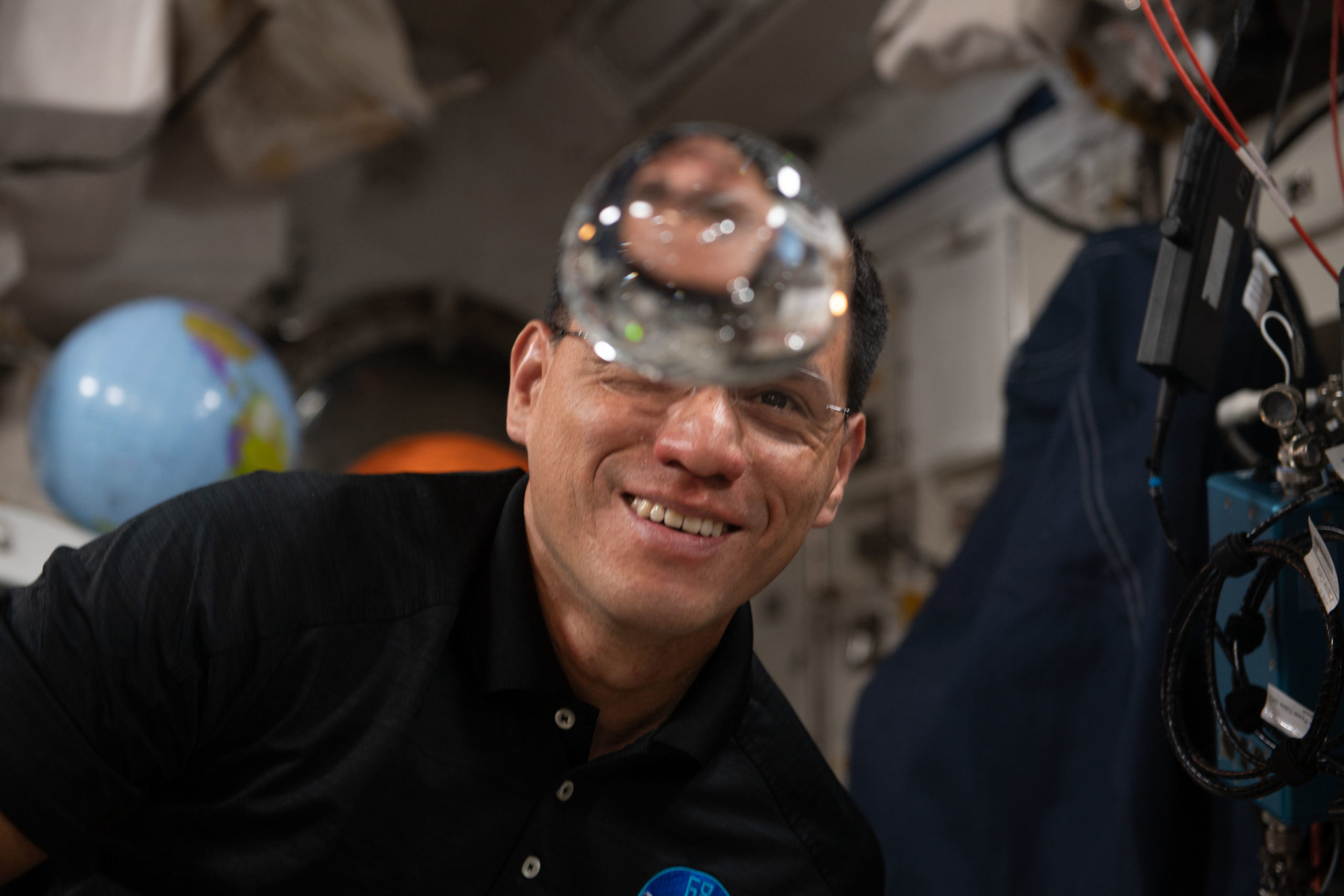
At 9:54 a.m. EDT tomorrow, Expedition 69’s Frank Rubio will officially become one of only four American astronauts to surpass 300 days in space on a single mission. But unlike his ultra-long-term predecessors on the International Space Station (ISS)—Scott Kelly, Christina Koch and the incumbent U.S. single-mission record-holder Mark Vande Hei—at the time of his launch from Russia’s Baikonur Cosmodrome in September of last year, Rubio anticipated no more than a “standard” increment of six months on the sprawling orbital complex and should have returned home back in March.
All that changed in December of last year.

Rubio left Baikonur’s storied Site 31/6, shoulder-to-shoulder with Russian cosmonauts Sergei Prokopyev and Dmitri Petelin aboard the Soyuz MS-22 spacecraft, at 6:54 p.m. local time (9:54 a.m. EDT) on 21 September 2022. “A sunset start,” noted NASA commentator Rob Navias as the rocket roared uphill, the flare of its center core and four tapering side-boosters momentarily turning back the encroaching evening.
A U.S. Army physician and helicopter pilot of Salvadoran heritage, the 46-year-old Rubio was the first U.S. astronaut to ride a Soyuz in more than a year as an “integrated” crew capability of seat-swaps between Russian and U.S. crewed vehicles officially got underway last fall. That capability, designed to protect against the grounding of either partner’s crewed capability to ensure that at least one Russian and at least one U.S. crew member would be aboard at all times, had been inked amid much controversy in July 2022, only months after President Vladimir Putin’s invasion of Ukraine.

Three hours and 12 minutes and two Earth orbits after launch, Prokopyev, Petelin and Rubio docked safely at the ISS, to be welcomed aboard the station by Expedition 67 Commander Oleg Artemyev, his Russian crew mates Denis Matveev and Sergei Korsakov, U.S. astronauts Kjell Lindgren, Bob “Farmer” Hines and Jessica Watkins, together with Italy’s Samantha Cristoforetti. A week later, Artemyev, Matveev and Korsakov returned to Earth aboard their Soyuz MS-21 spacecraft, wrapping up a six-month stay, and on 5 October Dragon Endurance launched from Pad 39A at Florida’s Kennedy Space Center (KSC), bringing with it the multi-national Crew-5 quartet: NASA astronauts Nicole Mann and Josh Cassada, Japan’s Koichi Wakata and the first Russian cosmonaut to ride a Commercial Crew vehicle, Anna Kikina.
Less than ten days after Crew-5’s arrival, Lindgren, Hines, Watkins and Cristoforetti boarded their Dragon Freedom spacecraft and returned to Earth to wrap up 170 days in orbit. At this stage—with Expedition 68 now underway—it was confidently anticipated that Prokopyev, Petelin and Rubio would spend 182 days aloft, targeting their own undocking and homeward-bound journey in the latter days of March 2023.

Under Prokopyev’s command lay several busy months in support of around 250 research investigations, ranging from modeling how the human brain adapts to microgravity to growing dwarf tomato plants and from hearing and ultrasound eye scans to 3D-printing of organ-like tissues. A cluster of six sessions of Extravehicular Activity (EVA)—both from the U.S. Operational Segment (USOS) and the Russian Operational Segment (ROS)—also took place between November 2022 and last February, including three by Rubio to continue installation of Boeing-built ISS Roll-Out Solar Arrays (iROSAs).
But plans for an end-of-March return for Prokopyev, Petelin and Rubio began to change on 14 December, when ground teams observed “significant” leakage from the aft end of Soyuz MS-22. A coolant loop leak was later pinpointed, emerging from the spacecraft’s external radiator.

Temperatures and humidity levels inside Soyuz MS-22 remained within acceptable parameters and inspections using the station’s 57.7-foot-long (17.6-meter) Canadarm2 robotic arm on 18 December revealed a small hole and discolouration on the radiator’s surface, suggestive of a Micrometeoroid Orbital Debris (MMOD) impact.
As 2023 began, it became obvious that although the spacecraft could be used in the event of an emergency return of the crew, it was not viable for the “nominal” return of Prokopyev, Petelin and Rubio. In mid-January, NASA and Roscosmos determined that a “replacement” ship, Soyuz MS-23, would launch uncrewed in February-March.

To facilitate an enhanced “lifeboat” capability, Rubio’s seat liner was transferred from Soyuz MS-22 over to Dragon Endurance on 17-18 January, with an expectation that it would be installed—along with Prokopyev and Petelin’s seat liners—aboard Soyuz MS-23 following its arrival. The replacement crew vehicle launched from Kazakhstan’s Baikonur Cosmodrome on 23 February and docked autonomously at the ISS two days later, carrying 946 pounds (429 kilograms) of payloads and supplies.
Seat liners for Prokopyev, Petelin and Rubio were transferred over to Soyuz MS-23 over the next few days and the ailing Soyuz MS-22 undocked in an uncrewed capacity on 28 March, parachuting safely back to Earth on 28 March after 188 days. It was reported that temperatures likely reached 50 degrees Celsius (122 degrees Fahrenheit) on landing, somewhat more favorable than the worst-case scenarios contemplated by mission planners, although further data remains to be seen.

With the next Russian crewed vehicle, Soyuz MS-24, now scheduled to launch from Baikonur on 15 September—carrying the “original” Soyuz MS-23 crew of Russian cosmonauts Oleg Kononenko and Nikolai Chub, together with NASA astronaut Loral O’Hara—the stay time of Prokopyev, Petelin and Rubio correspondingly lengthened to around a full year. Their return has now been pegged for 27 September 2023, which will see the three men return home after 371 days, the second-longest human flight ever conducted in the annals of space exploration.
Although several spacefarers have surpassed 300 days in orbit on a single mission, the majority have been Soviet and Russian, withYuri Romanenko first crossing its threshold near the end of his 326-day February-December 1987 stay aboard the Mir station. Cosmonauts Vladimir Titov and Musa Manarov were first to spend a full year on Mir—a couple hours shy of full 366 days—between December 1987 and December 1988.

Others have also crossed that magical ten-month limit: Sergei Krikalev logged 311 days aboard Mir during the fall of the Soviet Union between May 1991 and March 1992 and Sergei Avdeyev achieved 379 days during his own double-duty increment in August 1998-August 1999, humanity’s last long-duration mission before the millennium. But the current world record-holder for the longest human spaceflight is Russia’s Valeri Polyakov, who spent 14 months—437 days—on Mir between January 1994 and March 1995.
America has pushed its own long-duration capability more gradually, with 84 days set at the end of the final Skylab mission in February 1974 remaining its most extreme-length flight for more than two decades. That changed when NASA astronauts completed a series of stays aboard Mir in the mid-to-late 1990s: Norm Thagard logged 115 days between March and July 1995 and Shannon Lucid pushed the U.S. record to 188 days during her own March-September 1996 increment.

Further U.S. duration records awaited the ISS era. Astronauts Carl Walz and Dan Bursch logged 196 days by the end of their Expedition 4 increment in June 2002, an accomplishment pushed to 215 days by Mike Lopez-Algeria on Expedition 14 in April 2007 and eventually to 340 days by NASA’s Scott Kelly during his “One-Year Mission” with Russian cosmonaut Mikhail Kornienko between March 2015 and March 2016.
Three U.S. astronauts have preceded Frank Rubio in hitting a 300-day-plus mission—Kelly’s 340 days, followed by Christina Koch’s 328-day record for a single flight by a woman, set between March 2019 and February 2020, and Mark Vande Hei’s 355 days, completed in March of last year—but he will become the first American to cross the span of a continuous solar orbit in space.
And significantly, all three were confidently anticipated to fly ultra-long-duration missions before they left Earth. Kelly’s flight, of course, was planned for almost a year from the outset, whilst double-increment stays for both Koch and Vande Hei had been outlined (though not formally announced) at the time they launched. That proved not to be the case for Rubio, whose mission extension only entered the realm of realistic possibility deep into his ISS stay and under quite unanticipated circumstances.






6 Comments
6 Pings & Trackbacks
Pingback:Frank Rubio Reaches Day 300, Heads for First U.S. 12 months in House - technewscombuild.in
Pingback:Northrop Grumman Prepares for Final Antares 230 Launch Tomorrow - AmericaSpace
Pingback:Crew-7 FRR Concludes, Dragon Endurance Ready for Friday Pre-Dawn Launch - AmericaSpace
Pingback:Crew-6 Reflects, as Crew-7 Prepares - AmericaSpace
Pingback:Weather Favorable for Crew-7 Launch, Six-Month Space Station Stay Ahead - AmericaSpace
Pingback:Crew-7 Launches, Four Nations En-Route to Space Station - AmericaSpace